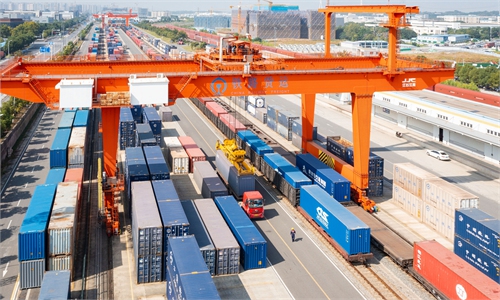Provincial regions achieve robust GDP growth, more signs of solid economic recovery

This aerial photo taken on Oct. 4, 2023 shows vehicles for self-driving tours and the scenery along a scenic coastal highway in Wenchang, south China's Hainan Province. The opened section of the scenic coastal highway in Hainan have attracted numerous tourists for self-driving tours during the Mid-Autumn Festival and National Day holiday. Photo: Xinhua
Several Chinese provincial-level regions achieved robust GDP growth in the first three quarters of 2023, with some expanding faster than the national growth rate of 5.2 percent, offering more signs of a continuous solid recovery in the world's second-largest economy.
As of Sunday, at least 12 provincial-level regions had released figures for third-quarter economic growth, according to media reports. South China's Hainan Province, a top tourist destination and one of the world's largest free trade ports in the making, led the way with remarkable growth of 9.5 percent.
Among the 12 regions, nine recorded growth rates faster than the national level, including North China's Inner Mongolia Autonomous Region, which saw a 7.2 percent growth rate, and East China's Zhejiang Province, one of the nation's economic powerhouses, with a growth rate of 6.3 percent.
Another highlight was growth of 5.3 percent in Northeast China's Liaoning Province, which has seen sustained downward pressure in recent years. It was the first time in a decade that Liaoning beat the national growth rate. Meanwhile, underscoring lingering challenges in some parts of the country, East China's Jiangxi Province saw a much lower growth rate of 3.4 percent in the first three quarters.
Overall, accelerating growth in provincial-level regions pointed to the sustained recovery of the Chinese economy, which recorded faster-than-expected growth in the third quarter despite downward pressure and risks, analysts said.
Cao Heping, an economist at Peking University in Beijing, said that thanks to an improvement in consumer sentiment and government support policies, major economic indicators improved significantly.
"That helped lift the GDP growth rate to 5.2 percent in the first three quarters, surpassing forecasts from major institutions and banks," Cao told the Global Times on Sunday.
Analysts noted that fast growth rates in some provincial-level economies also highlighted various aspects of China's high-quality development. Hainan's fast growth, for instance, underscored benefits from high-level opening-up, as the free trade port opened up more sectors and improved its business environment to attract global investors.
Another aspect of China's high-quality development lies in the increasingly consumption-led growth model. A recovery in consumption demand has led to fast growth in regions with strong resources and manufacturing capabilities, according to Cao, noting that many central regions also got a boost from structural changes and the inflow of industrial capacity from the coastal regions.
Such trends will continue and, coupled with continuous policy support, further boost China's GDP growth in the fourth quarter, analysts said. "In the fourth quarter, GDP growth will further accelerate," Cao said.
China's GDP grew by 4.9 percent in the third quarter, beating various forecasts.
In light of better-than-expected growth in the third quarter, many institutions have raised their forecasts for China's growth rate in 2023. JP Morgan, Citigroup and Nomura on Wednesday lifted their forecasts for China's economic growth for the year, according to Reuters.
Citigroup raised its forecast from 5 percent earlier to 5.3 percent, while JP Morgan expected growth rates of 5.2 percent and Nomura's forecast of 5.1 percent.



